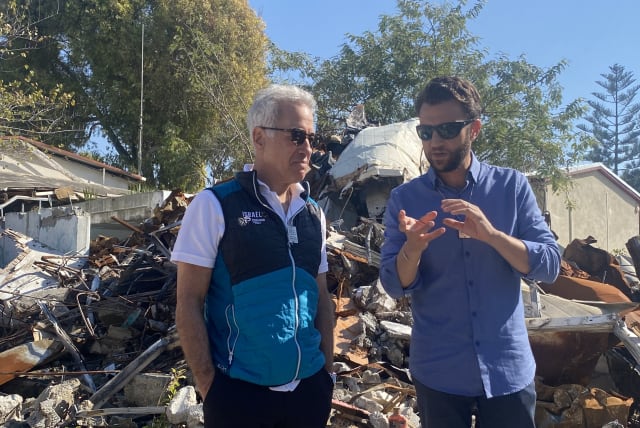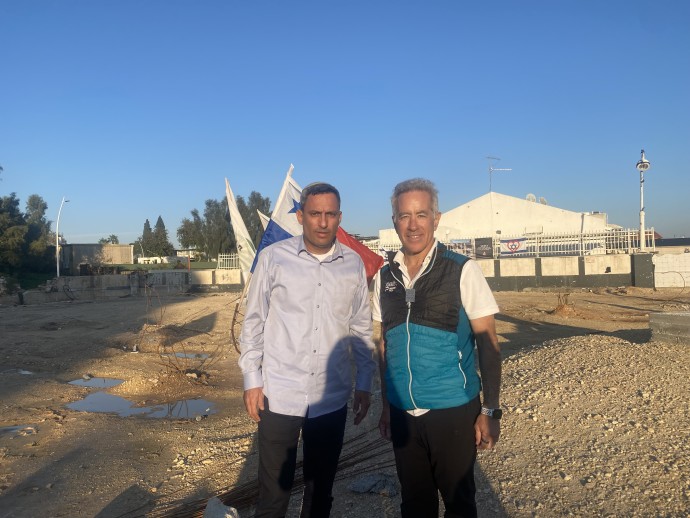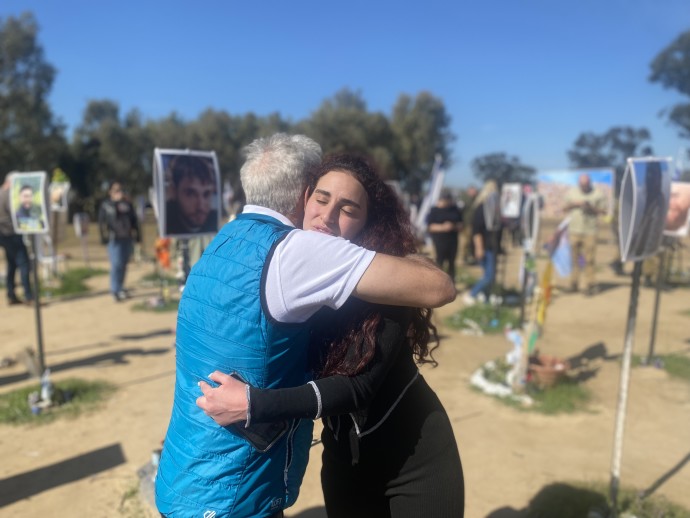Sylvan Adams: Working together to restore the South

With $100 million gift to Ben-Gurion University, Adams continues to drive development in southern Israel
Driving from Beit Shemesh southward, the signs along the road tell the story of the earth-shattering events, as well as the heroics of Oct. 7. Heletz Junction, Sderot, Sha’ar Hanegev, Alumim, Kfar Aza, and Kibbutz Re’im are names that are seared in the consciousness of all Israelis for years to come.
Our visit to the South was arranged as a fact-finding trip with Sylvan Adams, the noted Canadian philanthropist who, since his aliyah in 2015, has dedicated himself to showcasing his adopted country’s true face by sponsoring events that present Israel to the world at large.
Adams is the owner of the Union Cycliste Internationale (UCI) professional cycling team, Israel-Premier Tech, which competes at the highest level of the sport, including the annual Tour de France. Adams has also brought numerous world-class sporting events to Israel. These include the Giro d’Italia Gran Partenza (Big Start) featuring the first three stages of the 2018 Giro d’Italia Grand Tour bicycle race; the French Trophée des Champions (Super Cup) in Tel Aviv in August 2022; and the Ironman Middle East Championship, which was held in Tiberias in November 2022.
Unlike these upbeat events, the visit to the sites of the Hamas attack on Oct. 7 was somber and subdued. Our first destination was the Kibbutz Re’im picnic area, where Hamas murdered 364 Israelis who had gathered for the Superova music festival.
Chen Malca from Jerusalem, 25, who attended the festival and miraculously escaped, recounted her experiences to Adams.
“At 6 a.m., we saw drones in the air,” she recalled. “We thought they were part of the festival, and everyone was waving at them.
“We saw sparks in the sky a few minutes later and thought they were fireworks.” The music stopped, and Malca saw the missiles overhead.
“I felt the earth shake.”
Malca, her cousin, and her boyfriend raced to their car and sped to the exit, along with hundreds of other escaping vehicles.
At first, they were reassured when they saw men wearing olive-green IDF shirts, but when Malca noticed that their black pants did not match the shirts, she realized that they were terrorists.
“We turned around four times without knowing where we were going,” Malca told Adams.
They continued driving and arrived at Kibbutz Sa’ad, together with others who had escaped from Rei’im. The Hamas terrorists also attacked Sa’ad, but the kibbutz emergency squad, together with the IDF, thwarted their plans.
“We had a miracle there,” she said to Adams. “We didn’t know we were going to Kibbutz Sa’ad. We could have just as easily gone to Kibbutz Be’eri or Kfar Aza.”
Adams listened intently to Malca’s chilling reconstruction of what she had experienced. When she finished, Adams hugged Malca and told her, “God saved you for a reason. You have to remember that, and dedicate your life and do something important and special.”
October 7 inspiration
For Adams, the outbreak of the war on Oct. 7 inspired him in early December to make a transformational $100 million donation to Ben-Gurion University of the Negev in Beersheba, aimed at advancing education and campus life at BGU while rebuilding and strengthening the South.
On that dark day, when Hamas terrorists rampaged through the southern communities, Ben-Gurion University lost 82 members of its community, including students, staff, faculty, and their family members.
Adams said of his $100 million gift, “This is our answer to October 7. We build, while they destroy. BGU is solving humanity’s greatest challenges – the challenges of our planet, such as desert ecology, water management, solar energy, sustainable development, environmental physics, and climate change. We’re solving the greatest planetary challenges of our time, while next door to us they built terror tunnels and munitions to destroy rather than build. We teach our children to love, while they teach theirs to hate. This is the contrast. We have our Jewish values, and we will continue to be a force for good in the world.
“This important investment in Israel’s South tells everyone – Israelis, our neighbors, and all others abroad – that we are here to stay!”
As he lives in Israel, Adams has received numerous requests to join efforts to help rebuild the communities in the Gaza border area. Diaspora-based foundations and private philanthropies have approached him, seeking his know-how in helping rebuild Israel’s South.
Leaving Re’im, Adams and his entourage continued to pastoral Kibbutz Be’eri, just five kilometers away, where on Oct. 7, hundreds of Hamas terrorists brutally murdered 130 people, burning houses, shooting, and throwing grenades. Our tour of Be’eri began with an inspirational visit to the ultramodern Be’eri Print, one of Israel’s leading printing facilities, both standard and digital, which, before the the war, boasted a workforce of 400 employees. Surviving, reopening
“Until October 7,” said Ben Suchman, CEO of Be’eri Print, “Be’eri was a peaceful, caring community of 1,300 people in what I saw as a paradise.”
Early on the morning of that fateful day, Suchman said, he and his family heard gunshots below their home and hid in the safe room of their apartment. At 10:30 a.m., his mother, who lived nearby, called and said that terrorists had entered her home. Suchman remained on the phone with her for two hours. He listened to the exchange between the terrorists and his mother until the call finally ended. Initial reports suggested that she had been kidnapped, but it was later confirmed that she was murdered.
Suchman and his wife and children survived and were rescued by the army at 3 a.m. the following morning. He determined that the printing facility needed to reopen as soon as possible as an indication that Be’eri was going to survive.
Despite the fact that many of the company’s employees were murdered or had relatives slaughtered by the Hamas terrorists and that the facility was located near the war zone, Suchman convinced Israel’s leaders that reopening Be’eri Print would be a symbol that would change the destiny of the kibbutz.
On Sunday, less than a week after the massacre, the printing house reopened. Today, 300 people are working there on site, with another 50 remotely connected from the Dead Sea hotels where Be’eri residents have been relocated.“I thought that Zionism had ended,” Suchman told Adams.
“I thought I was just a guy here enjoying his life in the best place in the world. But coming back here now is like what my grandfather did in 1946 when the kibbutz was founded.
“We have a mission, and we understand that Zionism has not ended.”
Adams is encouraging residents to return. While he admitted that some members may choose not to, he asserted: “Our mission is to make it happen and make those who are undecided believe that this place will prosper again.”
Adams said, “I’m imploring the government to provide the funding to allow us to rebuild the homes and bring the people back quickly. We’re going to win this war, of course. It may take another few months, but in the meantime, let’s start rebuilding our communities in the Gaza border area. We want to bring the people back. I want more people to move to the South so that we have more population than was here before, and for us to build back bigger, better, and stronger communities in the South. That is why I invested in Ben-Gurion University, to create the economic impetus to further populate those communities.” On the ground in the South
The next portion of our visit was perhaps the most difficult.
Lotan Pinyan, 43, who has lived in Be’eri since 2002, took our group through some of the hardest-hit areas of the kibbutz.
Pinyan lived through the horrors of Oct. 7, hiding in the safe room of his home with his wife and three children for many hours.
At 7:30 on that fateful morning, he wrote on the kibbutz WhatsApp group that terrorists were near his door. Seconds later, he was astonished to see similar messages from many other residents. Pinyan realized that what he thought was an isolated incident was a massive attack.
We stopped at the dental clinic in Be’eri, where Magen David Adom paramedic Amit Mann treated the wounded for hours until she was murdered by Hamas terrorists.
Pinyan showed us the symbols on the doors of homes that indicated that human remains had been found and had been removed. He explained that kibbutz residents believe that the terrorists were especially interested in burning the homes where children lived and set on fire those that had toys and children’s bicycles outside.
Pinyan took us to the nearby home of his in-laws, who were murdered and whose house was almost completely burned, and played back the recording of his mother-in-law’s last phone conversation.
Although he has been back there many times since the massacre and has undoubtedly told the story to many, he became quite emotional at the site. Pinyan is not certain if he will return to Be’eri, but he is optimistic that Be’eri will survive.
“The Jewish people are good at rising again. It is part of our DNA,” he said.
Cycling for the hostages
Kibbutz Be’eri holds a special place in Adams’s heart as the site of the Be’eri Singletrack, a 27-km. loop trail near the kibbutz that is extremely popular among Israeli mountain bikers. As owner of the Israel-Premier Tech cycling team,
Adams has showcased cycling to help promote the call for the release of the Israeli hostages.
In mid-January, his Israel-PremierTech team – in conjunction with the Foreign Affairs Ministry and the Hostage and Missing Families Forum – organized a worldwide bicycle ride in support of our hostages held in Gaza, with each rider attaching a yellow ribbon to his or her bike.
Hundreds of thousands of cyclists in over 40 cities on six continents united to free the hostages held in Gaza, marking the 100th day of their captivity. Ride locations included Toronto, Barcelona, Marbella, Paris, Brussels, Miami, Los Angeles, Washington, Melbourne, Sao Paulo, and Capetown. But the nerve center for this global ride was the Sylvan Adams National Velodrome in Tel Aviv, where symbolically, 136 cyclists rode, including family members of the hostages and of some who had been released. Each rider carried a photo of one of the hostages as they cycled in the stadium in a plea for their release.
“We rode for the hostages, brothers and sisters to us all. They are in our hearts,” Adams said.
The final leg of our visit to the southern communities was Sderot, where Adams met with Mayor Alon Davidi at the site of the police station that the Hamas terrorists had taken over. In the ensuing battle between the terrorists and Israel’s army and police forces, the building was destroyed and is now an empty lot. Davidi showed Adams a video of the events and detailed the plans to bring back the city’s residents in early March.
With his indomitable spirit, Adams is optimistic that Israel will emerge victorious.
Quoting the words of singer Ehud Manor, “‘Ein lanu eretz acheret’ – we have no other country,’” he said.
This article was written in cooperation with Sylvan Adams.
Jerusalem Post Store
`; document.getElementById("linkPremium").innerHTML = cont; var divWithLink = document.getElementById("premium-link"); if (divWithLink !== null && divWithLink !== 'undefined') { divWithLink.style.border = "solid 1px #cb0f3e"; divWithLink.style.textAlign = "center"; divWithLink.style.marginBottom = "15px"; divWithLink.style.marginTop = "15px"; divWithLink.style.width = "100%"; divWithLink.style.backgroundColor = "#122952"; divWithLink.style.color = "#ffffff"; divWithLink.style.lineHeight = "1.5"; } } (function (v, i) { });


